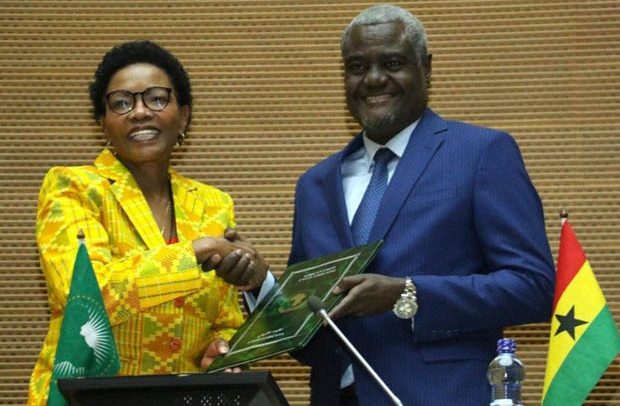Catherine Mwangi presents Kenya’s AfCTA documents to AU Commission chair Moussa Mahamat
Kenya yesterday became the second country after Ghana to submit legal instruments ratifying the Africa Continental Free Area Agreement to the Africa Union.
AU Commission Chairman Moussa Faki Mahamat received the documents from Ambassador Catherine Mwangi.
The two countries were among some 27 countries of the African Union’s Assembly, which ratified the agreement signed in Kigali, Rwanda on March 21, this year.
During the AU’s 10th Extraordinary Session, countries agreed that all member states should sign and ratify the AfCFTA agreement, which seeks to allow for free movement of goods and services throughout the continent.
According to the African Trade Policy Centre (ATPC) of the Economic Commission for Africa (ECA), the African Continental Free Trade Area (AfCFTA) will cover a market of 1.2 billion people and a gross domestic product (GDP) of $2.5 trillion across all 55 member States of the African Union, making it the world’s largest free trade area since the formation of the World Trade Organization.
The protocol commits governments to remove tariffs on 90 percent of goods produced within the continent and phase out the rest over time.
It could create tens of thousands of jobs and significantly reduce unemployment among the continent’s youthful population.
“The population of Africa is projected to reach 2.5 billion by 2050 at which point it will comprise 26 percent of what is projected to be the world’s working age population, with an economy that is estimated to grow twice as rapidly as that of the developed world.
“With average tariffs of 6.1 percent, businesses currently face higher tariffs when they export within Africa than when they export outside it. AfCFTA will progressively eliminate tariffs on intra-African trade, making it easier for African businesses to trade within the continent and benefit from the growing African market,” the ATPC explained.
Commitment
Many governments on the continent have expressed keenness. For example, the South African department of trade and industry has indicated it is “committed to a coordinated strategy to boost intra-Africa trade and to build an integrated market in Africa that will see a market of over a billion people with a GDP of approximately $2.6 trillion (£1.85trillion).”
Also, Kenya’s trade ministry has noted it will not only create a massive liberalised market, but will also “enhance competitiveness at the industry and enterprise level, enhance value addition of products and exploit economies of scale and optimum utilization of resource”.
Obstacles
However, the deal encountered its first challenge.
A few days to the meeting, Nigeria announced that President Muhammadu Buhari would not attend the ceremony in Kigali.
Giving reasons for the absence, the Nigerian government said that “certain key stakeholders in Nigeria indicated that they had not been consulted for which reasons they had some concerns on the provisions of the treaty.”
Those key stakeholders are Nigeria’s business community and its trade unions.
The trade unions are thought to be particularly concerned about a free trade area, given that it could develop into a much more integrated body, which would see the free movement of workers across borders and threaten Nigerian jobs.
Also Uganda’s President Yuweri Museveni pulled out of the meeting.
Stages and benefits
The AU explained that under a free trade area agreement, all the African signatory countries will have to agree to reduce the trade tariffs and import quotas to boost intra-African trade.
This is the first stage of closer economic cooperation with a view to possible integration.
The next stage would be a customs union, where each country would have the same tariffs with the outside world and low or no tariffs in Africa.
Intra-Africa trade currently stands at about 14 percent with the agreement expected to facilitate an increase to about 52.3 percent by 2022.


